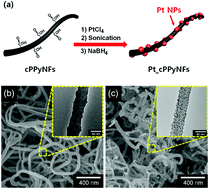Platinum nanoparticles immobilized on polypyrrole nanofibers for non-enzyme oxalic acid sensor†
Abstract
Oxalic acid (OA), naturally available in many fruits and vegetables, reacts easily with Ca2+ and Mg2+ ions to produce an insoluble salt. In renal systems, this insoluble salt brings about various renal diseases. As such, the OA excretion level in urine has been utilized as an index parameter in healthcare settings. Here, we report the fabrication of platinum nanoparticle-immobilized polypyrrole-3-carboxylated nanofibers (Pt_cPPyNFs) to apply as a transducer material for a non-enzyme field-effect transistor (FET)-type OA sensor. To achieve uniformly decorated Pt on carboxylated polypyrrole nanofibers (cPPyNFs), ultrasonication and chemical reduction were introduced as a Pt immobilization process. The Pt_cPPyNFs were immobilized on an interdigitated array (IDA) electrode for our sensor application. The resulting Pt_cPPyNF based non-enzyme FET-type OA sensor exhibited high sensitivity at unprecedentedly low concentrations (10–14 M); this was attributed to the uniformity of the Pt-nanoparticle decoration and distinct properties of the FET configuration. In addition, high stability was achieved in repeated experiments and under ambient storage conditions.



 Please wait while we load your content...
Please wait while we load your content...